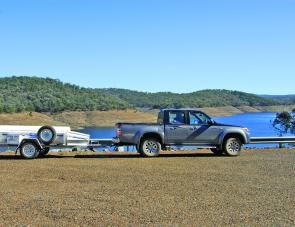As a replacement for the long standing Mazda Bravo series of off road utilities the Mazda BT50 seems to have it all. There's smoother styling, a larger payload, increased performance and very good fuel economy compared to its predecessor.
These days there are no less than 13 vehicles in the BT50 range, from a 2.5L 4x2 diesel through to the ritzy dual cab 4x4 powered by a state of the art common rail four cylinder 3.0L diesel.
All of the new BT50's feature a high standard of finish, lots of onboard luxuries for the driver and a ride that won't see passengers gritting their teeth with each bump. Maximum payload has been increased from 1371kg (from the old Bravo series) to 1430kg and tow capacity has seen an increase from 1800kg to 2500kg. For boat and camper trailer owners this increase is of real significance as is the fact that the BT50's work Ute heritage means that it only comes in diesel power – petrol is out.
A dual cab 4x4 BT50 was reviewed for this article. It is a five seater (2 front, 3 back) which I considered to be ideal for family use as well as serious work. There's plenty of comfort inside; sufficient room in the generous cargo space to accommodate a family team's fishing and camping gear with an option of a fibreglass canopy in lieu of the well fitted tonneau cover. A manual gearbox was a feature of the test vehicle, although an auto is also available in the top of the range SDX model which features 4x4 operation via an electronic shift.
I found the reviewed Mazda's manual five speed gearbox and feather light clutch to be a great combination which made driving in the city just as easy as cruising an open highway with the camper in tow.
A couple of points were outstanding with the new BT50. The diesel engine was remarkably quiet and the levels of noise, vibration and harshness (the dreaded NVH and bane of all vehicle manufacturers) were just about absent. The interior finish was also very good with a two-tone colour scheme (grey with silver high lights) that was very easy on the eye. All the main dials for various controls including the excellent air conditioning and sound system were to the left in a stylish silver panel while the three main instruments were set up in large silver rings directly ahead of the driver.
The Mazda featured an excellent sound system with an MP3 compatible CD player. I found the FM radio to be a powerful unit in contrast to some of those fitted to modern vehicles which simply fade into a frustrating fuzzy static outside of city limits.
In keeping with its market competitors the Mazda features power mirrors and windows as standard.
I managed to mix in some highway work along with a fair amount of city. At the wheel of the handsome Ute I had no trouble at all around the 'burbs as the wide side mirrors and totally unobstructed rear visibility allowed for easy monitoring of other road users. Also, the straightforward design of the vehicle simply does not create those dreaded blind spots that are a constant nuisance when driving some of the larger four-wheel drive vehicles. The driving position of the BT50 was very comfortable in that there was ample seat travel plus a good amount of headroom. Even the tallest of drivers could wear their hat in the Mazda without crumpling it one bit.
On the highway the powerful 3L engine made for easy and effortless cruising. The new diesel engine is equipped with a variable geometry turbo plus an intercooler to feed cooled air to the turbo prior to compression and fuel ignition. These features combine to provide smooth, seemingly effortless power.
As an aside, so efficient are the new 2.5 and 3L turbo diesels in the BT50 that both of these engines meet stringent Euro Stage IV emission compliance requirements which speaks heaps of their efficiency. Cruising at highway speeds saw the tacho on a modest 2,000 rpm with 100 kph on the speedo; but the real story is in the engine's brisk performance. It had terrific acceleration capability, anywhere from 1,200 to 3,000 rpm which was ideal for the overtaking lane.
Mazda have also upgraded safety features within the new BT50. The ABS anti-lock brake systems and electronic brake force distribution are available on all but the entry-level single cab chassis 4x2 model. Moreover, all 4x4 models employ a Limited Slip Differential at the rear wheels.
The suspension package is much the same as the old Bravo – double wishbone front, rear leaf springs - but the fhe system is more refined these days to offer a smoother ride. On a trip to Stanthorpe and during some off-road around the Glenlyon dam I could not bottom out the suspension or notice it rebounding harshly on uneven or pot holes surfaces. Fuel economy was noted as 9.6L per 100km/h while towing the camper which I considered to be good.
With 13 models, ranging from $23,255 for the single cab chassis model through to the dual cab utility SDX at $45,550 the BT 50 has a formidable line up. All drive well, perform well and will fulfil a host of requirements. It's just a matter of finding the one that suits the individual or family best.
Reads: 6336
The BT50's neat contemporary styling catches the eye.

The bold front is highlighted by the Mazda logo.

Away from the bitumen the BT50 had ample power to tow the Trek Kudu camper trailer.

A smart and entirely practical dash layout is a BT50 feature.

BT50 owners will be happy with the tow capacity of their Ute.




